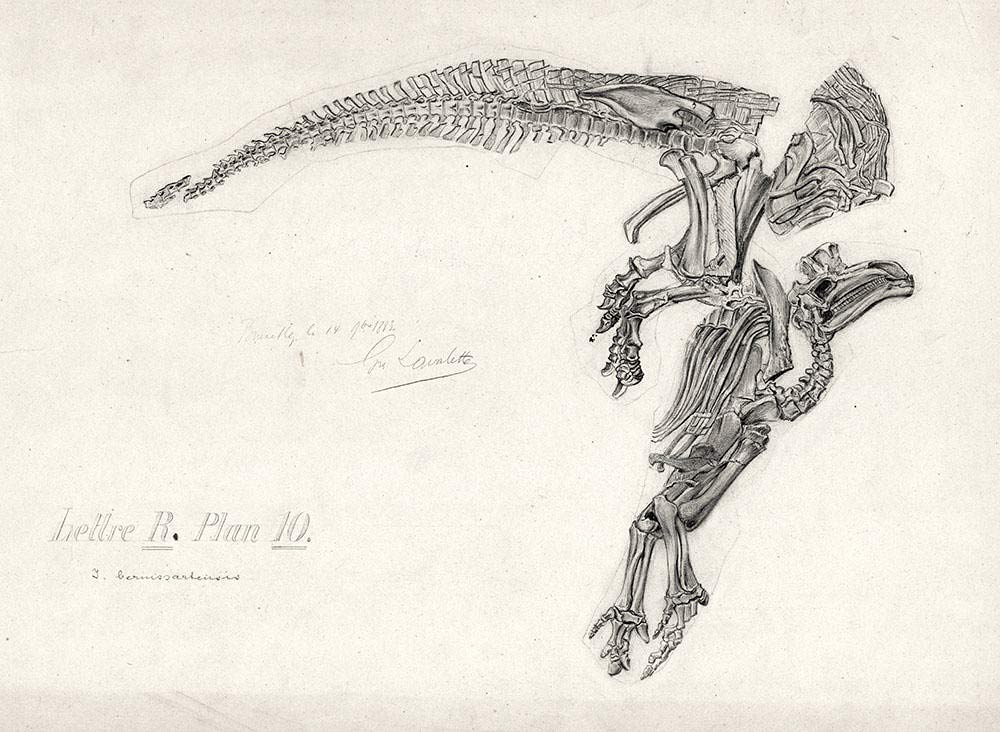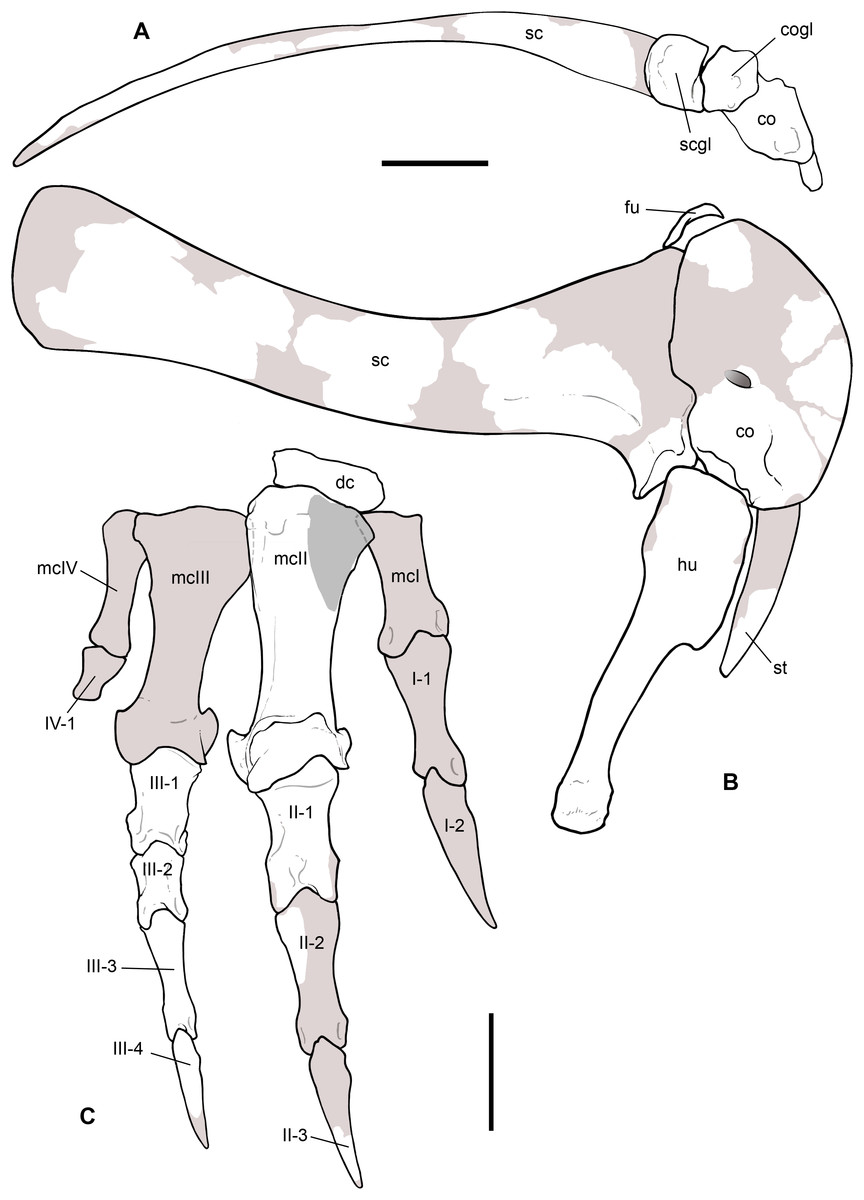|
Tethyshadros Insularis
''Tethyshadros'' ("Tethys Ocean, Tethyan hadrosauroid") is a genus of hadrosauroidea, hadrosauroid dinosaur from Trieste, Italy. The type and only species is ''T. insularis''. Discovery and naming Sometime in the 1980s, Alceo Tarlao and Giorgio Rimoli reported finding fragments of dinosaur bone while prospecting for rare bones. The abandoned quarry these were found in was only 100m inland, at Villagio del Pescatore, Trieste Province, Italy. It was from this quarry that a nearly complete hadrosaur skeleton was discovered in 1994. Lying on a vertical rockface, the specimen required a difficult excavation process, involving the removal of over 300 cubic metres of mineral and use of large equipment. Palaeontologist Fabio Della Vacchia among others served as scientific director for the excavation. Many other fossils, including various other hadrosaur specimens, were uncovered in the process. The main skeleton was not extracted until 1999. The significance of the find was immediately ... [...More Info...] [...Related Items...] OR: [Wikipedia] [Google] [Baidu] |
Late Cretaceous
The Late Cretaceous (100.5–66 Ma) is the younger of two epochs into which the Cretaceous Period is divided in the geologic time scale. Rock strata from this epoch form the Upper Cretaceous Series. The Cretaceous is named after ''creta'', the Latin word for the white limestone known as chalk. The chalk of northern France and the white cliffs of south-eastern England date from the Cretaceous Period. Climate During the Late Cretaceous, the climate was warmer than present, although throughout the period a cooling trend is evident. The tropics became restricted to equatorial regions and northern latitudes experienced markedly more seasonal climatic conditions. Geography Due to plate tectonics, the Americas were gradually moving westward, causing the Atlantic Ocean to expand. The Western Interior Seaway divided North America into eastern and western halves; Appalachia and Laramidia. India maintained a northward course towards Asia. In the Southern Hemisphere, Australia and Ant ... [...More Info...] [...Related Items...] OR: [Wikipedia] [Google] [Baidu] |
Acynodon
''Acynodon'' is an extinct genus of eusuchian crocodylomorph from the Late Cretaceous, with fossils found throughout Southern Europe. Classification The genus ''Acynodon'' contains three species: ''A. iberoccitanus'', ''A. adriaticus'', and ''A. lopezi''. Fossils have been found in France, Spain, Italy, and Romania, dating back to the Santonian and Maastrichtian periods of the Late Cretaceous. When first described in 1997, it was placed within the family Alligatoridae. New findings a decade later led to it being reclassified as a basal globidontan. Recent studies have since resolved ''Acynodon'' as a basal eusuchian crocodylomorph, outside of the Crocodylia crown group, and a close relative to ''Hylaeochampsa''. Description The skull of ''Acynodon'' is extremely brevirostrine; it had a very short and broad snout compared to other known alligatorids. Its dentition was quite derived, with enlarged molariform teeth and a lack of maxillary and dentary In anatomy, the mandible ... [...More Info...] [...Related Items...] OR: [Wikipedia] [Google] [Baidu] |
Duino Castle
Duino Castle ( it, Castello di Duino, german: Schloss Duino, sl, Grad Devin) is a fourteenth-century fortification located in Duino (municipality of Duino-Aurisina), near Trieste, Italy, on the cliffs overlooking the Gulf of Trieste. Building commenced in 1389 at the order of the Wallsee family. The ruins of an older castle built in the eleventh century by the Patriarch of Aquileia are located on the grounds. In the nineteenth century, it became one of two residences for Prince Alexander von Thurn und Taxis and his wife Princess Marie of the Czech branch of the House of Thurn und Taxis. While not the wealthiest of the Thurn und Taxis line, Alexander and Marie supported artists and writers, among these included Bohemian-Austrian poet Rainer Maria Rilke. While a guest of Princess Marie in early 1912, Rilke began to write his ''Duino Elegies'', a collection of ten long deeply philosophical and mystical poems which are considered to be his greatest work. Rilke dedicated his work to ... [...More Info...] [...Related Items...] OR: [Wikipedia] [Google] [Baidu] |
Holotype
A holotype is a single physical example (or illustration) of an organism, known to have been used when the species (or lower-ranked taxon) was formally described. It is either the single such physical example (or illustration) or one of several examples, but explicitly designated as the holotype. Under the International Code of Zoological Nomenclature (ICZN), a holotype is one of several kinds of name-bearing types. In the International Code of Nomenclature for algae, fungi, and plants (ICN) and ICZN, the definitions of types are similar in intent but not identical in terminology or underlying concept. For example, the holotype for the butterfly '' Plebejus idas longinus'' is a preserved specimen of that subspecies, held by the Museum of Comparative Zoology at Harvard University. In botany, an isotype is a duplicate of the holotype, where holotype and isotypes are often pieces from the same individual plant or samples from the same gathering. A holotype is not necessarily "typ ... [...More Info...] [...Related Items...] OR: [Wikipedia] [Google] [Baidu] |
Latin
Latin (, or , ) is a classical language belonging to the Italic branch of the Indo-European languages. Latin was originally a dialect spoken in the lower Tiber area (then known as Latium) around present-day Rome, but through the power of the Roman Republic it became the dominant language in the Italian region and subsequently throughout the Roman Empire. Even after the fall of Western Rome, Latin remained the common language of international communication, science, scholarship and academia in Europe until well into the 18th century, when other regional vernaculars (including its own descendants, the Romance languages) supplanted it in common academic and political usage, and it eventually became a dead language in the modern linguistic definition. Latin is a highly inflected language, with three distinct genders (masculine, feminine, and neuter), six or seven noun cases (nominative, accusative, genitive, dative, ablative, and vocative), five declensions, four verb conjuga ... [...More Info...] [...Related Items...] OR: [Wikipedia] [Google] [Baidu] |
Specific Name (zoology)
In zoological nomenclature, the specific name (also specific epithet or species epithet) is the second part (the second name) within the scientific name of a species (a binomen). The first part of the name of a species is the name of the genus or the generic name. The rules and regulations governing the giving of a new species name are explained in the article species description. For example, the scientific name for humans is ''Homo sapiens'', which is the species name, consisting of two names: ''Homo'' is the " generic name" (the name of the genus) and ''sapiens'' is the "specific name". Historically, ''specific name'' referred to the combination of what are now called the generic and specific names. Carl Linnaeus, who formalized binomial nomenclature, made explicit distinctions between specific, generic, and trivial names. The generic name was that of the genus, the first in the binomial, the trivial name was the second name in the binomial, and the specific the proper term for ... [...More Info...] [...Related Items...] OR: [Wikipedia] [Google] [Baidu] |
Hadrosauroidea
Hadrosauroidea is a clade or superfamily of ornithischian dinosaurs that includes the "duck-billed" dinosaurs, or hadrosaurids, and all dinosaurs more closely related to them than to ''Iguanodon''. Their remains have been recovered in Asia, Europe, Africa and the Americas. Many primitive hadrosauroids, such as the Asian ''Probactrosaurus'' and ''Altirhinus'', have traditionally been included in a paraphyly, paraphyletic (unnatural grouping) "Iguanodontidae". With cladistics, cladistic analysis, the traditional Iguanodontidae has been largely disbanded, and probably includes only ''Iguanodon'' and perhaps its closest relatives. Classification The cladogram below follows an analysis by Andrew McDonald, 2012, and shows the position of Hadrosauroidea within Styracosterna. The cladogram below follows an analysis by Wu Wenhao and Pascal Godefroit (2012). Cladogram after Prieto-Marquez and Norell (2010). A phylogenetic analysis performed by Ramírez-Velasco ''et al.'' (2012) foun ... [...More Info...] [...Related Items...] OR: [Wikipedia] [Google] [Baidu] |
Type Species
In zoological nomenclature, a type species (''species typica'') is the species name with which the name of a genus or subgenus is considered to be permanently taxonomically associated, i.e., the species that contains the biological type specimen(s). Article 67.1 A similar concept is used for suprageneric groups and called a type genus. In botanical nomenclature, these terms have no formal standing under the code of nomenclature, but are sometimes borrowed from zoological nomenclature. In botany, the type of a genus name is a specimen (or, rarely, an illustration) which is also the type of a species name. The species name that has that type can also be referred to as the type of the genus name. Names of genus and family ranks, the various subdivisions of those ranks, and some higher-rank names based on genus names, have such types. [...More Info...] [...Related Items...] OR: [Wikipedia] [Google] [Baidu] |
Saltrio
Saltrio is a ''comune'' (municipality) in the Province of Varese in the Italian region Lombardy, located about northwest of Milan and about northeast of Varese, on the border with Switzerland. As of 31 December 2004, it had a population of 2,925 and an area of .All demographics and other statistics: Italian statistical institute Istat. Saltrio borders the following municipalities: Arzo (Switzerland), Clivio, Meride (Switzerland), Viggiù Viggiù (; lmo, Vigiǘu, label= Varesino ) is a ''comune'' (municipality) in the Province of Varese in the Italian region Lombardy, located about northwest of Milan and about northeast of Varese, on the border with Switzerland. Viggiù border .... Demographic evolution Colors= id:lightgrey value:gray(0.9) id:darkgrey value:gray(0.8) id:sfondo value:rgb(1,1,1) id:barra value:rgb(0.6,0.7,0.8) ImageSize = width:455 height:303 PlotArea = left:50 bottom:50 top:30 right:30 DateFormat = x.y Period = from:0 till:4000 TimeAxis ... [...More Info...] [...Related Items...] OR: [Wikipedia] [Google] [Baidu] |
Saltriovenator
''Saltriovenator'' (meaning "Saltrio hunter") is a genus of ceratosaurian dinosaur that lived during the Sinemurian stage of the Early Jurassic in what is now Italy. The type and only species is ''Saltriovenator zanellai''; in the past, the species had been known under the informal name "saltriosaur". Although a full skeleton has not yet been discovered, ''Saltriovenator'' is thought to have been a large, bipedal carnivore similar to ''Ceratosaurus''. Discovery and naming On 4 August 1996, the first remains of ''Saltriovenator'' were discovered by amateur paleontologist Angelo Zanella, searching for ammonites in the ''Salnova'' marble quarry in Saltrio, northern Italy. Zanella had already been working for the ''Museo Civico di Storia Naturale di Milano'' and this institution after being informed sent out a team to investigate the find. Cristiano Dal Sasso and the volunteers of the Paleontological Group of Besano, under the direction of Giorgio Teruzzi managed to salvage a numbe ... [...More Info...] [...Related Items...] OR: [Wikipedia] [Google] [Baidu] |
Scipionyx
''Scipionyx'' ( ) was a genus of theropod dinosaur from the Early Cretaceous of Italy, around 113 million years ago. There is only one fossil known of ''Scipionyx'', discovered in 1981 by an amateur paleontologist and brought to the attention of science in 1993. In 1998 the type species ''Scipionyx samniticus'' was named, the generic name meaning "Scipio's claw". The find generated much publicity because of the unique preservation of large areas of petrified soft tissue and internal organs such as muscles and intestines. The fossil shows many details of these, even the internal structure of some muscle and bone cells. It was also the first dinosaur found in Italy. Because of the importance of the specimen, it has been intensely studied. The fossil is that of a juvenile only half a metre (twenty inches) long and perhaps just three days old. Its adult size is unknown. ''Scipionyx'' was a bipedal predator, its horizontal rump balanced by a long tail. Its body was probably covered b ... [...More Info...] [...Related Items...] OR: [Wikipedia] [Google] [Baidu] |




_(2).jpg)
